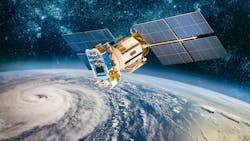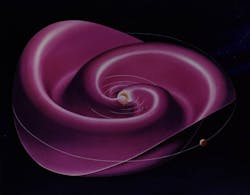Quiescent-Current Sheets Orbiting in Space
This article is in TechXchange: Why Low Iq is the Smart Thing to Do
Members can download this article in PDF format.
What you'll learn:
- What is a quiescent-current sheet?
- How these sheets separate plasma in space.
- Main sources of harmful radiation from space particles in electronics.
In the cold, dark void of space, we find an amazing phenomenon that’s made up of plasma. This is a charged gas made up of electrons and ions in which thin current sheets are separating large regions of plasma.
We all know the three states of matter: solid, liquid, and gas. However, most of us aren’t aware of another state known as plasma. Plasma actually occupies 99.9% of the observable universe.
If we could strip off electrons from an atom, the electrons become free. You’re now left with positive ions and free electrons—this is known as a plasma. A good example that we often see is the occurrence of a lightning discharge we can witness as a flash across the sky. The lightning flash is caused by an electrical current that’s heating the ordinary gas to a very high temperature. This enables a plasma column, which we can see glowing.
Plasma conducts electricity that’s not possible with an ordinary gas. This effect is composed of electricity and magnetism.
Quiescent-Current Sheets
As engineers and technicians, we all know about quiescent current in electronics. The broader definition of quiescent is “a state or period of inactivity or dormancy.”
Our Sun's magnetic field fills the entire solar system known as the heliosphere. All eight planets (Pluto was the ninth planet at one time) orbit inside of it.
Due to the tilt of the magnetic axis in relation to the axis of rotation of the Sun, the heliospheric current sheet (HCS), defined as a surface that separates regions of the heliosphere where the interplanetary magnetic field points toward and away from the Sun, flaps like a flag in the wind. The swirling, waving current sheet separates areas of oppositely polarity magnetic fields known as sectors (see figure).
The rotating Sun is located in the center of the figure. The wavy current sheet circles the Sun's equator and will become far wavier when the Sun's magnetic field flips.
As Earth orbits the sun, it dips in and out of the wavy current sheet. On one side, the sun's magnetic field points north (toward the Sun) on one side of the wavy sheet; the other side points south, which is oriented away from the Sun. South-pointing solar magnetic fields tend to cancel Earth's own magnetic field. Solar wind energy can then penetrate the local space around our planet and fuel geomagnetic storms.
HCSs are seen as a sprawling surface where the polarity of our Sun's magnetic field changes from plus (North) to minus (South). A small electrical current, of about 10−10 A/m² flows within the current sheet. The thickness of the current sheet is about 10,000 km and is fairly close to the orbit of the Earth.
Relatively thin quiescent-current sheets separate large regions of plasma in space. In 2012, scientists from the Swedish Institute of Space Physics (IRF) were able to finally measure the fundamental properties of one of the waves that was mixing and accelerating plasmas within those thin current sheets.
Plasma regions near the Sun’s hot solar surface are separated by these types of thin current sheets. Scientists believe that similar boundaries also must be common around the distant stars out in the vast universe.
They surmise that in many large regions of space, the plasma is too delicate and fine for the particles to actually collide. However, because these particles are charged, electric fields caused by some of these particles will interact with other particles. Quite frequently, some very specific waves in the electric field interchange energy between the plasma particles. These waves will replace ordinary collisions.
What Happens to Electronic Devices in Space?
Charged particles in space are sources of ionizing radiation that can damage electronics in space.
There are three main sources of harmful radiation from particles in outer space: ion particles emitted by the Sun, ion particle clouds of galactic cosmic radiation, and ion particles trapped in Earth’s magnetic field. These ion particles were atoms that were pulled apart as they traveled at extremely high speeds through space, separating the nucleus from its electrons.
Solar particles will have a radiation effect on electronics. Such solar particles are made up of protons and heavier ions.
Ionizing radiation moves through materials, and changes them when it passes through. This typically knocks the electrons out of the materials’ atoms, and causes them to be ionized. Below are two effects that are main contributors to space radiation hazards in electronics:
Total ionizing dose (TID)
This kind of effect is a time-dependent degradation of electronic components and devices when they’re continuously bombarded by ionizing radiation. The cumulative damage will cause degraded functionality, threshold shifts, increased device leakage, and larger power consumption.
Radiation on spacecraft electronics
A single-event effect (SEE) will occur when a heavy ion deposits a charge in most any device and in turn affects its functionality. High-energy protons also will typically cause SEEs in sensitive electronic devices. SEEs can trigger problems in space-based electronic systems such as frozen bits, gate rupture, and operating currents that go beyond electronic device specifications.
SEEs also will wreak havoc with operational problems that can occur in spacecraft electronics.3,4 The following are some of the primary causes:
- Ions in space radiation will likely interact with the integrated-circuit components to flip the states of bits and cause memory errors.
- If a high-energy ion or proton passes through the inner transistor junctions, this will likely cause a latch-up condition and lead to short circuits.
- High-energy particle radiation also will likely set electrons loose in a circuit, causing irreversible damage.
Undesired events on a space mission, such as memory losses, problem code execution sequences, latchups, and more, can all lead to disastrous events in a space mission. Some of these issues may only be corrected via a hard reset, while some may cause permanent damage to the integrated circuitry.
Spacecraft that are experiencing radiation-induced degradation of their solar panels will receive damage from particles/area/time of electrons at a particular energy (1 MeV). This kind of damage will usually decrease with increased thickness of protective coverglass on the solar panels.
Summary
The solar wind and the galactic interstellar medium (ISM), which is the matter and radiation that exists in the space between the star systems in a galaxy, are both fluids. The heliosphere's shape and size also are fluid. However, changes in the solar wind will significantly alter the fluctuating position of these boundaries on short timescales consisting of a few hours to a few years.
And, of course, our Sun is Earth’s greatest source of radiation and continuously emits all wavelengths contained in the electromagnetic (EM) spectrum. The most powerful wavelengths are in the form of visible, infrared, and ultraviolet (UV) radiation.
Occasionally, huge explosions known as solar flares occur on the Sun’s surface, releasing huge quantities of energy out into space in the form of x-rays, gamma rays, and streams of protons and electrons. This is known as a solar particle event (SPE). Solar flares may cause serious consequences to astronauts and spacecraft electronics, even if they are far from the Sun.
Read more articles in TechXchange: Why Low Iq is the Smart Thing to Do
References
1. Thin current sheets in space: where the action is, Swedish Institute of Space Physics, 2012.
2. The Heliospheric Current Sheet, NASA 2013.
3. Space grade electronics: How NASA’s Juno survives near Jupiter, The Planetary Society, 2018.
4. Space Engineering Enters Its Next Frontier, Rick Nelson, Electronic Design, 2022.

